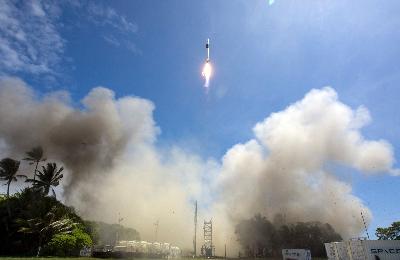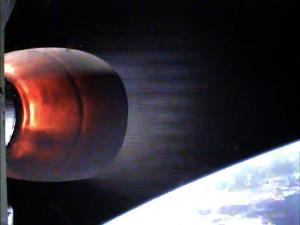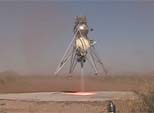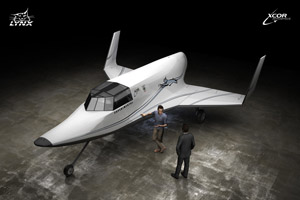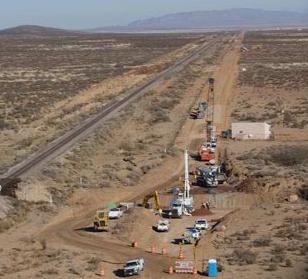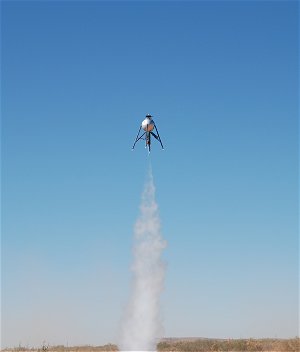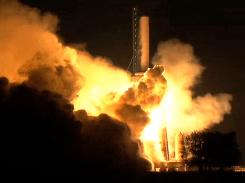The bottom line at the top: 2008 was a very good
year for NewSpace.
I present here a compilation of major events and accomplishments
for NewSpace
during 2008. The list comes primarily from a scan of
postings on my Space
Transport News blog, which had a very busy 12 months.
It's a subjective list, of course. I surely left out
some items that others believe should be included. (Contact
me if you find something missing.) However, I think
it provides a good overview of progress made in the
past year.
2008 saw several major milestones reached and many
significant accomplishments. Furthermore, there were
no outright catastrophes like the fatal accident at
the Scaled Composites engine testing facility in July
2007. You can compare this 2008 review with NewSpace
in 2007 review.
Here are a couple of other reviews of NewSpace in 2008:
While I have this
long definition of NewSpace, a shorthand distinction
between conventional space and NewSpace can be summarized
as Wholesale vs Retail.
The wholesale paradigm: space markets will never
expand beyond a very limited range of government and
industrial customers. The public will interact with
space only indirectly via services such as GPS systems
and satellite TV. The number of rocket launches to orbit
per year worldwide will not grow significantly beyond
the hundred or so that we see today and getting a payload
to space will always cost several thousand dollars per
kilogram.
The retail paradigm: the space industry will
become much larger by offering new spaceflight applications,
such as space tourism, directly to the public. Highly
reusable, robust and reliable space transports will
bring down the cost of spaceflight significantly as
economies of scale are generated with higher flight
rates. (This doesn't mean everyone will be going to
space anytime soon. A couple of thousand people taking
suborbital spaceflights each year and a hundred or so
paying to go to orbit per year would revolutionize the
industry.) On the long term, large scale human settlement
in space will take place.
With this distinction, it should be clear from their
business plans which companies fall into the NewSpace
category and which do not. Also note that this distinction
makes it quite possible for an innovative entrepreneurial
company not to be in NewSpace and for a big mainstream
aerospace company, or at least a subsidiary or subgroup
within it, to have full membership in the NewSpace movement.
In 2008 we did not see the opening of space settlements
on the Moon or the launching of a low cost single-stage-to-orbit
spaceship. It will be many years before NewSpace accomplishes
such things. It is important to understand that the
NewSpace approach involves a process of step-by-step,
incremental development rather than giant leaps. The
model follows that of most commercial technologies.
For the next few years, I believe the major goals
for NewSpace include the following:
- Continue to demonstrate that rocket and space hardware
can be developed with much less funding than what
the mainstream aerospace industry typically requires.
(See this
list of previous examples of low cost NewSpace
style hardware projects.)
- Attain aircraft-like operations for rocket vehicles:
- Rocket engines and other components must become
highly reliable, robust, and reusable over many
flights, i.e. perform as reliably and safely as
turbojets.
- Turnaround and flight operations must be simplified
and need only small crews.
- Robustness against problems is designed in from
the start. Only the most extreme component failures
should lead to catastrophes.
- Move towards vehicle designs that allow for
gradual envelope expansion during testing.
- Use high flight rates to improve continually
the hardware and achieve greater and greater reliability.
- Rocket missions will become known as "flights"
rather than "launches".
- Demonstrate viable human spaceflight business models
- Seek profitability at an early stage.
- Use profits at each step to fund the next
step
- Attract markets large enough to sustain high
flight rates, which in turn will lead to lower
costs and steady improvements in reliability and
safety.
Below I give a detailed
accounting of NewSpace progress in 2008. However,
the list is so long, I will first give a list here of
the top ten NewSpace successes in 2008. I think all
of these indicate significant steps towards the above
goals.
- Falcon 1 reaches
orbit
Not only was this a major achievement for SpaceX but
it helps bring credibility to the NewSpace industry
as a whole. It was the first privately developed liquid
fueled vehicle to reach orbit. Virtually all of the
components were developed and manufactured in-house.
The F1 acts as testbed for components for Falcon 9.
The first three launches, each of which failed for
a particular design problem, involved essentially
3 different rockets due to extensive hardware modifications.
- ISS cargo resupply
services contract
Awarded by NASA to SpaceX and Orbital Sciences, this
was the culmination of a decades long effort by space
advocacy organizations to push NASA to take a services
approach to space transportation. Rather than develop
rockets in house, NASA should simply offer contracts
to whichever companies that offer the best price for
delivery of payloads to orbit. The next step is for
NASA to do this also with crew transportation to orbit.
- Armadillo wins
the Lunar Lander Challenge, Level 1
Third time is charm for Armadillo. They win $350k
with their Mod vehicle. Armadillo also signed contracts
with the Rocket Racking League for the rocket racer
propulsion system and for a suborbital spaceflight
vehicle program, both of which share technology from
the LLC vehicles.
- XCOR
flies the X-Racer at Oshkosh
XCOR successfully carried out three exhibition flights
of its rocket racer at the Oshkosh air show. Later
at Mojave, XCOR flew its rocketplane seven times in
one day. The engine has been fired around 500 times
with little sign of wear.
- WhiteKnightTwo
flies for the first time
The WK2 design was unveiled in January, the plane
rolled out in July and flew on December 21st.
- XCOR begins hardware
development of the Lynx
Lynx rocketplane design was unveiled in March, hardware
construction began in the fall, the first passenger
and the company that will market the vehicle were
introduced in December, and the Lynx engine was fired
for first time in December.
- Spaceport
America gets off the ground
Sierra county votes to provide funding (Otero county
did not but its contribution was small and can be
replaced), road construction starts, in December the
spaceport obtains its FAA license, signs up a construction
management firm, and also signs a 20 year lease with
Virgin Galactic.
- ZERO-G gets NASA
contract for parabolic flight services
In January ZERO-G received a contract from NASA for
some parabolic research flights. In December, Mike
Griffin announced that all NASA parabolic research
activities would move to ZERO-G. Another example of
a commercial services approach by NASA.
- ISS
tourism shows strength
Richard Garriott carries out an extensive educational
and public outreach program on his ISS visit and he
also is paid for commercial microgravity experiments.
Sergey Brin signs up for a flight. Charles Simony
signs up again. Esther Dyson signs up as a backup.
Space Adventure announces that it has contracted with
the Russian space agency for Soyuz flights to carry
2 passengers starting in 2011.
- Science/Engineering
research on suborbital spaceflight vehicles gains
support
Alan Stern initiates a study program at NASA, which
continues after he leaves. A successful workshop was
held in San Francisco in December. Apps include astronomy,
space science, solar, microgravity, and other types
of science as well as engineering tests of components
intended for spacecraft are the sort of applications
that could supplement space tourism markets for the
vehicle operators.
Two sad events occurred in 2008 with the deaths of
these pioneers in entrepreneurial space:
Len
Cormier began working in the space industry in the
1950s and he devoted much of his life to developing
lower cost access to space. See his Tour2Space
website for info on some of his projects.
Jim
Benson was a successful computer industry entrepreneur
before he founded SpaceDev
with the goal of developing low cost spacecraft. SpaceDev
also built the hybrid propulsion system for the SS1.
He later started BensonSpace to develop a suborbital
space tourism vehicle.
Below I give a detailed accounting of significant NewSpace
accomplishments in 2008. In a manner similar to last
year's review, I've partitioned the list into the
following categories.
For each category, I split the entries into Ups
and Downs according to whether the events represented
positive or negative steps towards NewSpace goals.
|


